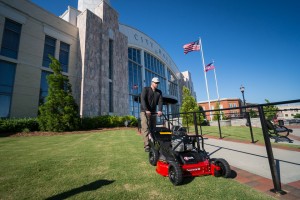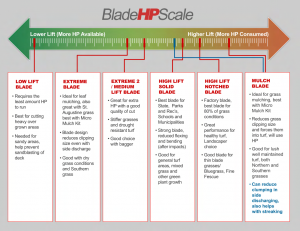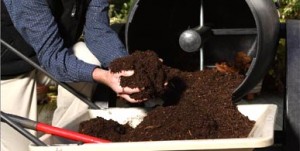While opinions differ on whether bagging or mulching is better for your lawn, the truth is there are valid reasons for using either. Ultimately, it depends on the conditions. Which one is most appropriate of course is a decision based on a number of factors, not the least of which is the height and condition of the grass itself, and the level of moisture in the lawn.
Why and when to mulch grass clippings
The process of mulching doesn’t just cut the grass once and let it drop. Instead, a mulching mower cuts each grass blade numerous times, so the clippings pass through the standing grass instead of laying on-top. This allows nutrients from the decomposing clippings to be returned to the lawn, reducing the need for fertilizer by up to 25 percent, experts say.
The clippings also help to retain moisture in the lawn and increase its resistance to erosion, which can be especially helpful on sloping properties.

Some Exmark walk-behind mowers, such as this Commercial 30, can seamlessly switch from bagging to mulching, depending on the need.
Mulching works best when the grass you’re mowing is on the dry side and you stick to the “Rule of Thirds”. Simply put, don’t cut more than one-third of the total blade length when you mow. This is good practice for a number of reasons, regardless of which clipping distribution or collection method you choose, but it’s especially important when mulching. This is due to the increased horsepower requirements of cutting each blade of grass multiple times in the mulching process.
When you overload a mulching mower with too-tall grass, too much speed, or both, things can progress to clogging very quickly. That makes it worth your while to mow frequently and take your time when mowing taller grasses while mulching.
Conditions when it’s typically favorable to mulch include during lawn development or in periods of drought or high temperatures.
It’s a good idea to collect clippings periodically, particularly during times of colder, wetter weather, or if you notice significant thatch build up.
Potential downsides of mulching
Thatch build-up is the biggest potential downside of frequent mulching. While some thatch build up is beneficial for moisture retention and erosion resistance, a thick thatch blanket can trap too much moisture and perpetuate fungus growth.
Annual aeration and/or dethatching of the lawn can be useful in keeping thatch at a healthy level.

Depending on conditions and what you’re doing with the clippings, you can select a blade for your Exmark mower that’ll work well.
As mentioned earlier, mulching requires more horsepower from the mower engine, which makes quickly mowing tall grass a challenge for many mowers, especially consumer models. We offer blades in a variety of lifts for Exmark mowers, so an owner can choose a blade, or blades, that will work best for the conditions they mow in.
Downsides of bagging
While the curb appeal of a bagged lawn is tough to deny, the cost of bagging yard waste and sending it to the landfill is significant. It’s estimated that grass clippings comprise 10 to 20 percent of the solid waste collected by communities on a year-round basis, and during summer months, grass clippings can account for nearly half the total weight of waste collected in some communities.
Bagging a lawn also robs it of the opportunity to benefit from the nitrogen and other vital nutrients mulched clippings can return to the soil. As a result, the lawn will need an increased amount of fertilizer over the year to maintain its health and vitality. It will also require more water to be applied, as more water evaporates during the heat of each day.
In-the-yard uses for grass clippings

Composting tumbler bins ease the process of converting grass clippings to compost. Image: EarthEasy.com
Grass clippings are useful around the yard and garden, most commonly as mulch or compost.
Composting yard waste creates incredibly nutrient-rich medium that can be used to fortify the soil in the garden, and for planting or potting. It should be noted that compost should be used in addition to soil for planting, not as a planting medium itself.
When it comes to the decision to mulch or bag, it’s clear there’s no one “right” answer. But taking the time to understand what conditions you’re dealing with, and what will be best for your lawn, the right answer will become apparent to you.
If you still have questions on what will be best for your lawn, a consultation with your county extension agency or a local landscape professional can help get you on the right track.
Resources for more information:
- University of Idaho College of Agriculture Cooperative Extension System
- HowStuffWorks.com
- AllAboutLawns.com
- University of Missouri Extension






